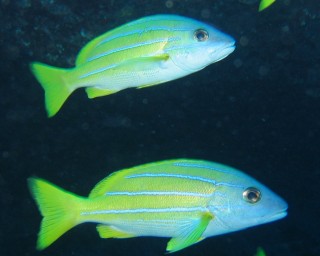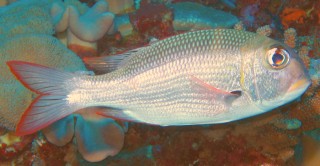
|
Underwater Pages Reef Animals |
Snappers & Breams
Snappers have pretty classic fish shapes, with sloping heads and forked tails. Their mouths are large, with prominent canine teeth used for feeding on other fish, gastropods and crustaceans. They feed primarily at night, though they do school around divers who offer fish bits. They tend to live in shallow to medium depths.
Coral breams (aka Sea Breams or Emperors) family Lethrinidae have a shape similar to the snappers, but their mouths are smaller, not extending past the eyes. Most are solitary and tend to hang out just above the sand waiting for prey. Despite the grandiose name of "Emperor" the fish are far less dramatic than other reef fish. Of interest, though is that they can change color within seconds from a sandy-gray base to mottled pattern.
 This was taken in Vava'u, Tonga, on a September dive. Sometimes it's
hard to identify a fish from a photo - the colors vary
so much depending on the source of light, the depth, and the reflection
on scales. But Michael Brogan of the University of Washington,
a former ichthyologist in the Gulf of California with a broad familiarity with
Indo-West Pacific reef fishes wrote to say:
This was taken in Vava'u, Tonga, on a September dive. Sometimes it's
hard to identify a fish from a photo - the colors vary
so much depending on the source of light, the depth, and the reflection
on scales. But Michael Brogan of the University of Washington,
a former ichthyologist in the Gulf of California with a broad familiarity with
Indo-West Pacific reef fishes wrote to say:
"It looks to me like your mystery fish is a fine Monotaxis grandoculus or the Big-eye Emperor. This is a member of the family Lethrinidae, a close relative of the snappers (Lutjanidae). You've probably seen many other kinds of Lethrinids on your wonderful travels (there are about 40 species), but most the other species aren't as deep-bodied, they have more pointed snouts, and smaller eyes. A few are more colorful. The Big-eye Emperor (or 'Mu' as they call them in Hawaii) has a unique look among the family members. Emperors are also known as Sea Breams."
The Big-Eye Emperor, Monotaxis grandoculus is known in our ID book as the Humpnose Bigeye Bream and we didn't recognize it. We appreciate Dr. Brogan's input! To show some of the various colors this fish can take we've included the adult (above) and the sub-adult.
Top Level: Home | Destinations | Cruising Info | Underwater | Boat Guests | Ocelot | Sue | Jon | Amanda | Chris | Site Map | Make a Comment
|
If our information is useful, you can help by making a donation |
Copyright © 2000‑ Contact: Jon and Sue Hacking -- HackingFamily.com, svOcelot.com. All rights reserved.